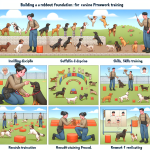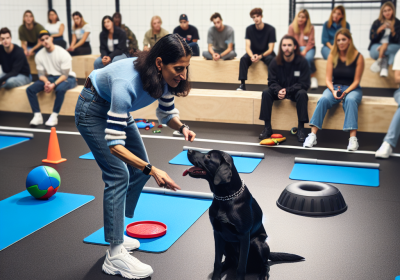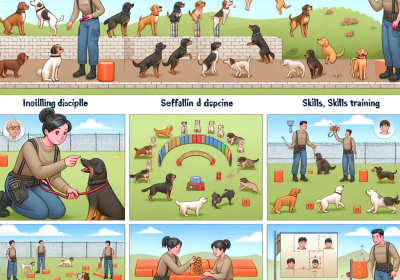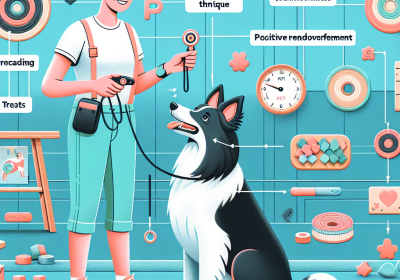Common Training Mistakes to Avoid in Canine Freework
Table of Contents
- Overloading Sessions: The Pitfalls of Excessive Training Time
- Ignoring Individual Needs: The Importance of Tailoring Training to Your Dog
- Inconsistent Commands: How Mixed Signals Can Hinder Progress
Training dogs in freework can be a rewarding experience, but it is essential to avoid common mistakes that can hinder progress and potentially harm the dog. One major mistake is inconsistency in commands and expectations, which can confuse the dog and slow down learning. Overtraining or pushing the dog too hard can lead to physical and mental fatigue, reducing the effectiveness of the training sessions. Neglecting to use positive reinforcement can result in a lack of motivation and engagement from the dog. Additionally, failing to properly socialize the dog can lead to behavioral issues and difficulties in various environments. Lastly, not tailoring the training to the individual dog’s needs and abilities can result in frustration for both the trainer and the dog. By being aware of these common pitfalls, trainers can create a more effective and enjoyable training experience for their canine companions.
Overloading Sessions: The Pitfalls of Excessive Training Time
In the realm of canine freework, a training method that emphasizes a dog’s natural behaviors and instincts, it is crucial to strike a balance between effective training and overloading the animal. One of the most common mistakes trainers make is overloading sessions, which can lead to a myriad of issues that ultimately hinder the dog’s progress. Understanding the pitfalls of excessive training time is essential for anyone looking to optimize their dog’s learning experience and overall well-being.
To begin with, it is important to recognize that dogs, much like humans, have a limited attention span. When training sessions extend beyond this natural limit, the dog can become mentally fatigued. This mental exhaustion can manifest in various ways, such as a lack of focus, increased distractibility, and even behavioral issues. Consequently, the effectiveness of the training diminishes, as the dog is no longer able to absorb and retain new information. By keeping sessions short and engaging, trainers can ensure that the dog remains attentive and responsive, thereby maximizing the benefits of each session.
Moreover, excessive training time can lead to physical fatigue, which is particularly detrimental in canine freework. This training method often involves activities that require a significant amount of physical exertion, such as agility exercises, scent work, and other tasks that tap into the dog’s natural instincts. When a dog is physically overworked, it becomes more prone to injuries and may develop a negative association with the training process. This can result in a reluctance to participate in future sessions, thereby stalling progress and potentially causing long-term setbacks.
In addition to mental and physical fatigue, overloading training sessions can also impact the dog’s emotional well-being. Dogs are highly sensitive creatures that thrive on positive reinforcement and a sense of accomplishment. When training sessions are excessively long, the dog may experience frustration and anxiety, particularly if it is unable to meet the trainer’s expectations. This emotional strain can erode the bond between the dog and the trainer, making it more difficult to achieve desired outcomes. By keeping sessions concise and celebrating small victories, trainers can foster a positive and supportive learning environment.
Furthermore, it is essential to consider the cumulative effect of overloading training sessions. While a single extended session may not cause immediate harm, the long-term impact of consistently overworking the dog can be significant. Chronic stress and fatigue can lead to a decline in overall health, affecting the dog’s immune system, digestive health, and even its lifespan. Therefore, it is imperative to adopt a sustainable approach to training that prioritizes the dog’s well-being.
To avoid the pitfalls of excessive training time, trainers should focus on quality over quantity. This involves setting clear, achievable goals for each session and being mindful of the dog’s limits. Incorporating regular breaks and allowing time for rest and recovery are also crucial components of a balanced training regimen. Additionally, trainers should be attuned to the dog’s signals, such as signs of fatigue or disinterest, and adjust the training schedule accordingly.
In conclusion, while the desire to achieve rapid progress in canine freework is understandable, it is essential to avoid the common mistake of overloading training sessions. By recognizing the limitations of the dog’s attention span, physical endurance, and emotional resilience, trainers can create a more effective and humane training experience. Prioritizing the dog’s well-being and adopting a balanced approach will ultimately lead to more successful outcomes and a stronger bond between the dog and the trainer.
Ignoring Individual Needs: The Importance of Tailoring Training to Your Dog
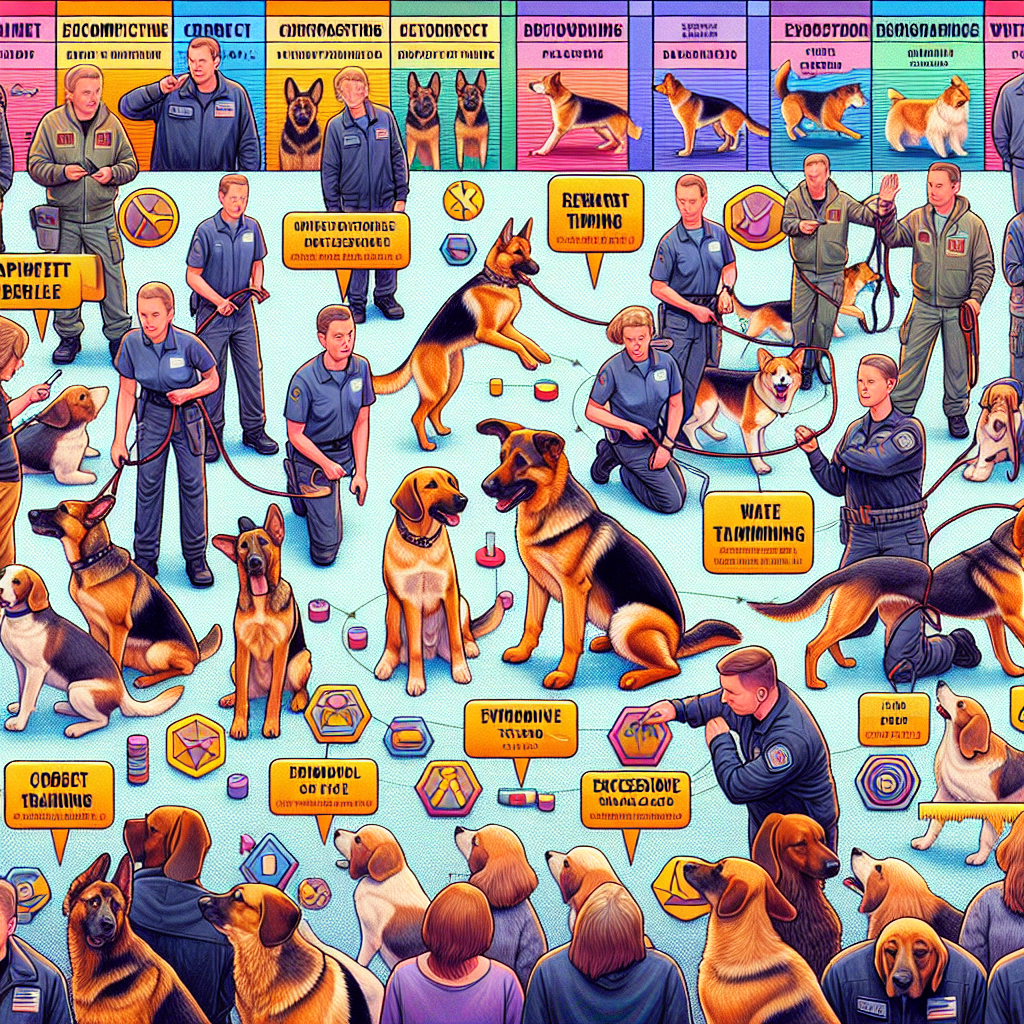
When engaging in canine freework, it is crucial to recognize and respect the individual needs of each dog. Ignoring these unique requirements can lead to ineffective training and potential behavioral issues. One common mistake is assuming that a one-size-fits-all approach will work for every dog. This oversight can result in frustration for both the trainer and the dog, ultimately hindering progress. Therefore, it is essential to tailor training methods to suit the specific characteristics and needs of each canine.
To begin with, understanding a dog’s breed, age, and temperament is fundamental. Different breeds have varying energy levels, learning capacities, and behavioral tendencies. For instance, a Border Collie, known for its high energy and intelligence, will require a different training approach compared to a more laid-back breed like a Basset Hound. Similarly, puppies and older dogs have distinct needs; puppies may have shorter attention spans and require more frequent breaks, while older dogs might need gentler exercises due to potential health issues.
Moreover, individual temperament plays a significant role in determining the most effective training methods. Some dogs are naturally more anxious or fearful, while others may be overly confident or assertive. Recognizing these traits allows trainers to adjust their techniques accordingly. For example, a timid dog might benefit from positive reinforcement and gradual exposure to new experiences, whereas a more dominant dog might require clear boundaries and consistent rules.
In addition to breed, age, and temperament, it is also important to consider a dog’s past experiences. Dogs with a history of trauma or neglect may exhibit behaviors that require specialized training approaches. Ignoring these factors can exacerbate existing issues and create new ones. Therefore, taking the time to understand a dog’s background and current emotional state is vital for effective training.
Another common mistake is failing to observe and respond to a dog’s body language. Dogs communicate primarily through non-verbal cues, and being attuned to these signals can provide valuable insights into their comfort levels and readiness to learn. Signs of stress, such as yawning, lip licking, or avoiding eye contact, indicate that a dog may need a break or a change in the training environment. Conversely, a relaxed posture and wagging tail suggest that the dog is engaged and receptive to learning.
Furthermore, setting realistic goals and expectations is essential. Pushing a dog too hard or expecting immediate results can lead to burnout and resistance. Instead, breaking down training tasks into manageable steps and celebrating small victories can build a dog’s confidence and motivation. Patience and consistency are key components of successful training, allowing dogs to progress at their own pace.
Incorporating variety into training sessions can also address individual needs. Just as humans can become bored with repetitive tasks, dogs benefit from diverse activities that challenge their minds and bodies. Rotating between different exercises, such as scent work, agility, and obedience training, can keep sessions engaging and prevent monotony.
Lastly, seeking professional guidance when needed can make a significant difference. Professional trainers have the expertise to assess a dog’s unique needs and develop customized training plans. They can also provide valuable feedback and support, helping to address any challenges that arise during the training process.
In conclusion, ignoring individual needs in canine freework is a common mistake that can impede progress and create behavioral issues. By understanding and respecting each dog’s breed, age, temperament, past experiences, and body language, trainers can tailor their methods to suit the specific requirements of their canine companions. Setting realistic goals, incorporating variety, and seeking professional guidance when necessary are all essential components of effective and compassionate training.
Inconsistent Commands: How Mixed Signals Can Hinder Progress
In the realm of canine freework, the importance of consistent commands cannot be overstated. This training method, which emphasizes a dog’s ability to make choices and engage in problem-solving activities, relies heavily on clear and consistent communication between the handler and the dog. However, one of the most common mistakes that can significantly hinder progress is the use of inconsistent commands. When handlers inadvertently send mixed signals, it can lead to confusion, frustration, and a lack of trust, ultimately impeding the dog’s ability to learn and perform effectively.
To begin with, it is essential to understand that dogs thrive on routine and predictability. They learn best when commands are clear, concise, and consistent. When a handler uses different words or gestures for the same command, it creates a confusing environment for the dog. For instance, if a handler sometimes uses the word “sit” and other times uses “down” to mean the same action, the dog may struggle to understand what is being asked of them. This inconsistency can lead to slower learning and a lack of confidence in the dog’s ability to perform the desired behavior.
Moreover, inconsistent commands can also affect the dog’s emotional state. Dogs are highly perceptive and can pick up on their handler’s frustration or confusion. When a dog receives mixed signals, it may become anxious or stressed, which can further hinder its ability to learn. This emotional turmoil can create a negative association with training sessions, making the dog less eager to participate and more likely to exhibit undesirable behaviors.
In addition to verbal commands, body language plays a crucial role in canine freework. Dogs are adept at reading human body language and often rely on these cues to understand what is expected of them. Therefore, it is vital for handlers to be aware of their own body language and ensure it aligns with the verbal commands being given. For example, if a handler says “stay” but their body language suggests they are about to move, the dog may become confused and unsure of what to do. Consistency in both verbal and non-verbal communication is key to successful training.
Furthermore, it is important for all individuals involved in the dog’s training to use the same commands and gestures. If different family members or trainers use varying commands for the same behavior, it can create a chaotic learning environment for the dog. Establishing a unified set of commands and ensuring everyone adheres to them can significantly enhance the dog’s ability to learn and perform consistently.
To avoid the pitfalls of inconsistent commands, handlers should take the time to establish a clear and consistent set of commands before beginning training. This includes deciding on specific words and gestures for each behavior and ensuring that everyone involved in the training process is on the same page. Additionally, it is beneficial to practice these commands regularly and reinforce them with positive reinforcement, such as treats or praise, to help the dog associate the commands with positive outcomes.
In conclusion, the use of inconsistent commands in canine freework can greatly hinder a dog’s progress and overall training experience. By prioritizing clear and consistent communication, handlers can create a more predictable and positive learning environment for their dogs. This not only enhances the dog’s ability to learn and perform but also strengthens the bond between the handler and the dog, leading to a more successful and enjoyable training journey.
Read more about Canine Freework
Training Strategies for Canine Freework
– Positive Reinforcement Techniques for Canine Freework
– Building a Strong Foundation for Canine Freework Training
– Common Training Mistakes to Avoid in Canine Freework
– Adjusting Training Methods for Different Types of Dogs
– Incorporating Canine Freework in Regular Training Sessions


